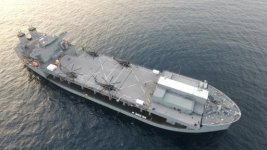Oldgateboatdriver
Army.ca Veteran
- Reaction score
- 2,503
- Points
- 1,010
Agree. Very slick presentation.
Colin, I know of Seaspan's web site progress pictures, but I don't recall seeing any videos. Are there any?
Also, for those who have viewed the Davie video, just a rhetorical question: How much delays and extra money do you think our East Coast Friend would have tried to "extort" from our government had they suffered a minor catastrophe like Davie having its dry dock flooded from the extraordinary river flood and high tides of this spring? Note that davie is still 90 % complete and indicates they are still ahead of schedule even with this drawback.
Colin, I know of Seaspan's web site progress pictures, but I don't recall seeing any videos. Are there any?
Also, for those who have viewed the Davie video, just a rhetorical question: How much delays and extra money do you think our East Coast Friend would have tried to "extort" from our government had they suffered a minor catastrophe like Davie having its dry dock flooded from the extraordinary river flood and high tides of this spring? Note that davie is still 90 % complete and indicates they are still ahead of schedule even with this drawback.




